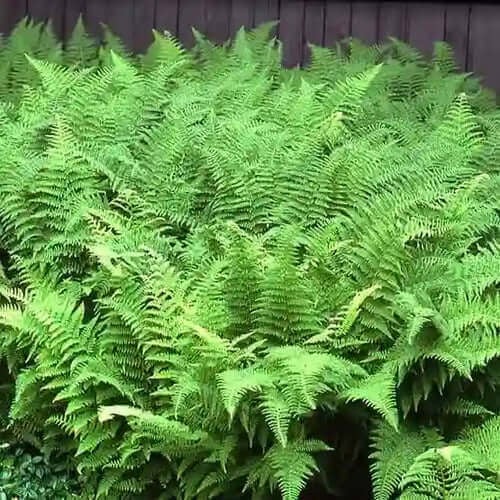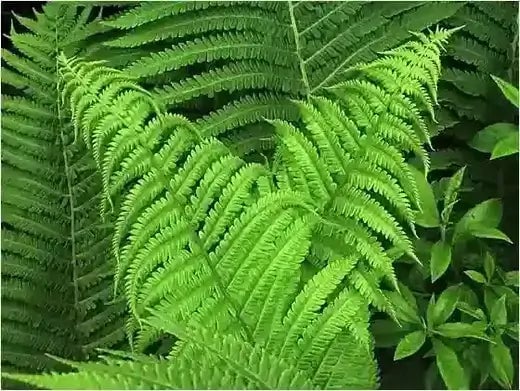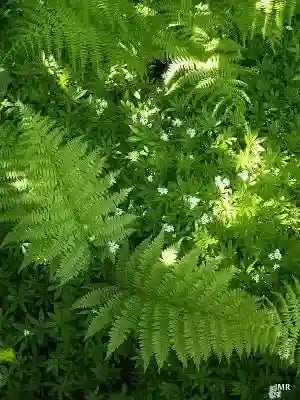5 Reasons To Plant Ferns
Are you tired of spending countless hours in your garden to keep your plants alive and healthy? If so, it's time to consider adding ferns to your outdoor space. Ferns are an excellent option for those who want a low-maintenance garden requiring little watering, pruning, or fertilization. They are easy to care for and add a lush, green, and natural touch to any landscape.
In this article, we'll explore five reasons with five ferns and why ferns should be your go-to plant for creating a low-maintenance garden. Whether a seasoned gardener or a beginner, you'll find plenty of reasons to love these beautiful, hardy plants.
If you've learned how to grow Ferns, you'll have many options for adding greenery to your garden. Ferns are incredibly easy to grow too. They are available in various colors, textures, sizes, and shapes.
They like to be cool and shaded, so this gives them a chance to establish themselves before the higher temperatures of winter or summer begin to set in. They will thrive in sunny areas if you ensure they're well-watered. If you plan to plant them in spring, you can mix in flowers like wood anemones, hellebores, cyclamens, and snowdrops, as they are excellent plant companions.
Maidenhair Fern
Maidenhair fern is a unique species native to two continents: North America in the United States and Canada and Asia in the Himalayan region. This graceful fern's low-maintenance and easy-growing requirements make it sought-after for shade.
Gardens, borders with shade garden beds, even on the slopes of ponds with shade. They are also great to plant on sloped hills and have less sunlight as they're much easier to cultivate than grass. The look is delicate; however, these ferns are tough. They're cold-tolerant, disease-resistant, and insect-resistant.
The fronds could grow up to 16" to 26" tall, and then the plant develops to form a beautiful oval at its base. The appearance of ferns with maidenhair can fool you. They come in a variety of small and fan-shaped sizes.
Leaflets are made up of one hair, which looks similar to hair.
Leaflets sport a vibrant spring green color with some coloration due to darker veins that contrast.
Maidenhair ferns are a pleasant species. They require little care and need a semi-shaded area and fertile soil. They sometimes enjoy adding wood compost or earthworm castings that give them vibrant growth.
The most crucial element is keeping the soil around your plants damp but not excessively. You are prepared if you reside in a rainy climate or a high-humidity zone. People who live in dry areas should plan to water their ferns every day in the summertime thoroughly.
Reason #1
Ferns are easy to care for: Ferns require very little care, making them an excellent choice for low-maintenance gardens. They thrive in the shade and do not require frequent watering or fertilization.
Hay Scented Fern
This low-maintenance species is a native plant of the Eastern United States. It performs well in all zones of temperate USDA zone of growth. They can flourish in all types of soils that range from dry woods and rocky forests to dense, moist hardwood forests. An important thing to consider is the soil condition and water quality. As with most ferns, the scent of hay is that it likes to remain moist and not get too wet or dry.
The gorgeous golden-brown stems support the crisp, spring-green fronds, creating the triangular shape. Each frond has bright leaflets that are large at the base and then sharpened to form a sharp tip towards the end. The frond's texture gives it an attractive hair-like, hair-like appearance.
The plant can reach an adult height of fewer than two feet. However, it can spread up to four feet. This growing pattern is an excellent ground cover or specimen plant in your shade garden. The plant is 3 feet wide and tall and can be quickly spread out for groundcovers.
Reason #2
Ferns are adaptable: Ferns can grow in various soil types and tolerate different sunlight and moisture levels. It makes them a versatile choice for gardens with varying conditions.
Ostrich Fern
Ostrich fern gets its name because of its springtime appearance. As new growth emerges in the springtime, the newly formed fronds sport the brown fuzzy layer known as the crown. When the fronds break, it falls off. The height is an oval shape on the top of the fronds. It is reminiscent of an ostrich tucking its head in to hide.
Matteuccia Struthiopteris is a vast and beautiful perennial fern with elegant, plume-like fronds that will draw much attention. They like a moist, partially shaded location within USDA zones 3-7.
Ostrich Fern is a stunning ornamental plant that makes a dramatic, elegant statement in any. It's ideal near the garden's back border or in natural areas near water features, an acquisition, or any other partially shaded area you could discover.
The process of planting and maintaining the ostrich fern is simple. The primary requirement is to plant it within a shaded spot because it needs indirect light, not sunlight. It will adapt to the sunrise sun but cannot tolerate the afternoon sun. It is attracted by fertile, moist soil with rapid and efficient drainage. It prefers a humid environment but is not a fan of wet roots for the course.
Reason #3
Ferns are attractive: Ferns come in various sizes and shapes, and their delicate fronds can add texture and interest to any garden. They are also available in shades of green, making them a visually appealing addition to any landscape.
Lady Fern
Beautiful and delicate Lady Ferns (Athyrium spp.) are a perfect match for their name. They vary in both size and structure. They can be upright while others spread. Lady ferns can tolerate dry, sun-lit soil and shed their leaves in the fall.
Lady Fern is a gorgeous green plant native to North Africa, Asia, and some regions in North America. It is distinguished by its vast, vibrant leaves. The Lady Fern is a favorite in the shade and is usually found in areas with woods.
The plant multiplies and can grow up to 5 feet. It begins with fiddleheads, which fall off and reveal delicate, long leaves. This attractive plant makes lavish greenery for any landscape and isn't too difficult to keep.
It's a great garden addition, particularly if you need to become more familiar with gardening. Overall, this variety of ferns is straightforward to care for and is aesthetically flexible. If you have a space in your garden that has beautiful shade and well-drained soil, this fern might be an excellent option for your garden.
Reason #4
Ferns are hardy: Ferns can withstand extreme temperatures and weather conditions, making them a durable choice for low-maintenance gardens. They are also resistant to pests and diseases, making them a low-risk option for gardeners.
Leatherwood Fern
Leatherwood fern is a challenging and weather-resistant North American native species that can withstand some of the coldest regions in the adjacent United States. It is semi-evergreen because the leaves might droop and go into dormancy during the coldest days, then open again when it becomes warmer.
Dryopteris Marginalis is a small semi-evergreen fern that can cover even your garden's dark and shadiest areas. The shade-loving fern needs less than four hours of sunlight for easy maintenance. It thrives best in USDA zones 3-8.
When placed in full shade, Dryopteris marginalia requires almost no care. It prefers a woodland area where it can share moisture with trees and get its nutrition from fallen leaves.
You'll only need to take care of it during a prolonged drought or heatwave. It may require a bit of watering. It's drought-resistant; therefore, give it enough to survive the dry season; it will bounce back quickly in the next storm.
Reason #5
Ferns are environmentally friendly.
Ferns are a natural garden choice, requiring no chemicals or pesticides to thrive. They are also a food source and habitat for many wildlife species, making them an eco-friendly garden option.
The Best Places to Plant Ferns
Gardeners seeking dense plant growth should choose ferns as they perform well in damp, shaded areas. These ancient plants show adaptability to various terrains but need essential elements for strong growth. Success with ferns requires understanding the best planting spots for both confined indoor settings and expansive outdoor gardens.
Most fern species grow best when they receive partial or complete shade. Ferns naturally grow on forest floors because taller trees allow filtered sunlight to reach the ground. Ferns require placement in indoor and outdoor spaces where direct sunlight lasts no more than two hours each day. Ferns can withstand some morning light or late afternoon rays, but direct, intense sunlight can damage their sensitive fronds. The ideal outdoor spots for planting ferns are beneath tree canopies or adjacent to walls that create dappled sunlight patterns.
Humidity is another must. The evolution of ferns in moist woodlands and tropical regions makes high humidity essential for their health. Natural humidity in your area provides an advantage for growing ferns. To increase moisture levels for ferns in dry areas, place them near ponds or water features. Grouping ferns close together will take advantage of transpiration, which benefits surrounding plants. You can maintain fern fronds indoors using humidifiers and adding moisture through occasional misting.
Soil type is critical, too. The ideal soil for most ferns should allow proper drainage while being abundant in nutrients similar to forest floor leaf detritus. Organic matter should be incorporated into clay or sandy soil to enhance its ability to retain moisture and promote better aeration. Avoiding waterlogged soil is crucial because many fern species strongly dislike such conditions, and raised beds provide an effective solution. Regularly water fern soil to maintain consistent moisture without making it waterlogged. Poor drainage conditions trigger root rot, which prevents fern growth.
Protection from wind is also important. Despite their appearance, fern fronds are brittle and break easily during strong wind gusts. Use walls, fences, or thick shrubs as barriers to protect ferns from wind damage and moisture loss. If you live in windy areas, you must frequently water ferns and observe their condition because wind can cause their leaves to dry quickly.
Residents with tight outdoor areas or harsh winter climates find container planting a flexible solution. You can adjust fern positions to match their requirements by using pots. Place ferns indoors by north- or east-facing windows to take advantage of soft lighting. The higher humidity levels in bathrooms make them a perfect spot for ferns. Potted ferns require regular soil moisture checks because they dry out faster.
Different fern species have varied sunlight requirements. Where ostrich ferns can tolerate more sun exposure with adequate watering, but other fern types need deeper shade to survive. Research the species to tailor placement. The dramatic appearance of ferns with tall arching fronds draws attention, while smaller fern varieties act as groundcovers to fill shaded areas.
Another factor to watch is temperature. Most ferns prefer mild, moderate conditions. Extreme temperatures can harm ferns by causing stress or leading to their death. People living in brutal winters should consider using mulch to protect the soil or bringing container ferns inside during winter. When growing ferns in extremely hot climates, keep them out of midday sun exposure and maintain regular watering schedules.
Rockeries and water features provide ideal growing conditions for ferns. Moss-covered rocks naturally preserve wetness to establish a cool microclimate similar to fern native environments. By planting in these areas, you achieve a layered effect that shades the soil and maintains root moisture.
Some fern species may become invasive because they spread through underground runners. You can use barriers or plant them in raised beds or containers to prevent ferns from spreading uncontrollably. Vigorous fern species can be controlled but will still add greenery to your garden.
Finally, mulch around your ferns. Degrading leaf mold or compost aids in soil enrichment while preserving moisture levels. It also discourages weeds, reducing competition. Just keep mulch from smothering the crown.
Most fern varieties prefer soil conditions that are slightly acidic to neutral, with pH levels between 5.5 and 6.5. To make the soil hospitable for shade plants in alkaline conditions, mix it with peat moss or apply sulfur.
The ideal location for fern planting requires a balance between shade levels, humidity conditions, soil quality, and protective shelter. Select locations that receive filtered light and provide sufficient moisture and mild environmental conditions. Protect ferns from harsh sunlight and powerful winds while considering container gardening or creating indoor spaces to improve adaptability. By following this method, you'll receive stunning fern fronds that create a tranquil atmosphere in your landscape or home. Gardens and interiors benefit from ferns because their timeless appeal and adaptability create a delightful presence. Provide ongoing patience.
Read more

Ferns are among the most sought-after plants for the home and have a valid reason. They are tough, flexible, adaptable, and simple to care for, making them ideal for both novices and experienced lo...

Ferns are usually found in moist, forested regions because they require a lot of water. Ferns thrive throughout all damp areas within New Zealand forests, forming the undergrowth underneath an ever...


